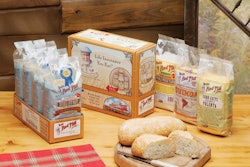
Tech Trend: Direct bottle printing
To speed bottling operations, reduce costs and waste, and increase shelf appeal, beverage marketers have for years been weighing their options for directly printing rather than labeling bottles.
Today, there are a number of options for direct printing bottles, both glass and plastic, and enough developments in the works to constitute the next wave of bottle and container decorating—a wave that might, ultimately, supplant applied labeling altogether in some sectors.
Back in the day—when energy was cheap, “sustainability” had not yet been coined as a manufacturing term, and beer and soft drinks were sold mostly in returnable glass bottles—applied ceramic labeling (ACL) was the bottle decorating and product identifying technology of choice. ACL silk screening in up to three colors provided armor-cladding graffiti to identify and protect bottles for “the float”—the 75 to 100 round trips the bottles would make from fillers to consumers before they broke. ACL inks contained heavy metals and were baked onto the surfaces of the bottles at lehr temperatures of about 1,200º F.
Modern direct glass bottle screen printing—an example of which is the new, limited edition Absolut Chicago vodka bottle from Ardagh Group—uses thermo-cured organic ink instead of glass enamel, and it’s cooler (about 400º F), faster, and more colorful than traditional ACL. Ardagh uses Ferro organic ink and Fermac printing equipment for the Absolut bottles.
Hartness International unveiled its UV Hartness Inks for direct printing and overall coating of glass bottles 10 years ago. The most prominent Hartness Inks application is the Lips of Faith beer bottles from New Belgium Brewing that carry Hartness Inks screen graphics. The coating solution offered by Hartness can transform flint glass bottles into cranberry red, cobalt blue or other exotic hues without compromising the recyclability of the flint glass.
Until recently, direct bottle printing was really only an option for glass bottles. But that’s changing. Earlier this year, KHS GmbH, the German-born, multinational machinery maker, debuted its Innoprint digital direct printing machine for PET bottles. The unit transfers color images with optical resolutions of 1,080 x 1,080 pixels onto the surface of PET bottles at speeds up to 600 per minute. In operation, the bottles are gripped by the neck and infused with sterile air for stability during printing.
Another German company with a new digital rotary printer for cylindrical containers including plastic bottles and metal cans is start-up Till GmbH. Based in Hattersheim, near Frankfurt a Main, Till was founded in 2011 and developed its Smartprint system for photo quality imaging on cylindrical containers last year. Speed, flexibility and cost savings, vs. traditional labeling ops, are the selling point that Till is pushing.
Market Trend: Cartons
(SUPs, Cups/Bowls/Tubs) challenge cans
Metal food and beverage can shipments in the U.S. have been slipping for a variety of reasons. Poor vegetable packs, bad weather, and rising interest rates are among the headwinds you hear about. You don’t hear so much (publicly) about the availability of alternative formats that offer some real and perceived advantages over the traditional cylindrical can, but that is contributing too.
Retortable stand-up pouches, shelf-stable barrier cups and a resurgence of interest in shelf-stable cartons are all nibbling away at the metal can’s food market. Latest, but not the last, packager to serve up soup in an “uncanny” package is General Mills, which early next year will introduce a line of Progresso Artisan soups in Recart cartons from Tetra Pak. Progresso is the biggest soup brand to adopt retortable cartons to date.
But we know it won’t be the last.
Ben Miyares, Packaging Sherpa, is a packaging market and technology analyst and is president of The Packaging Management Institute, Inc. He can be reached at [email protected].





























